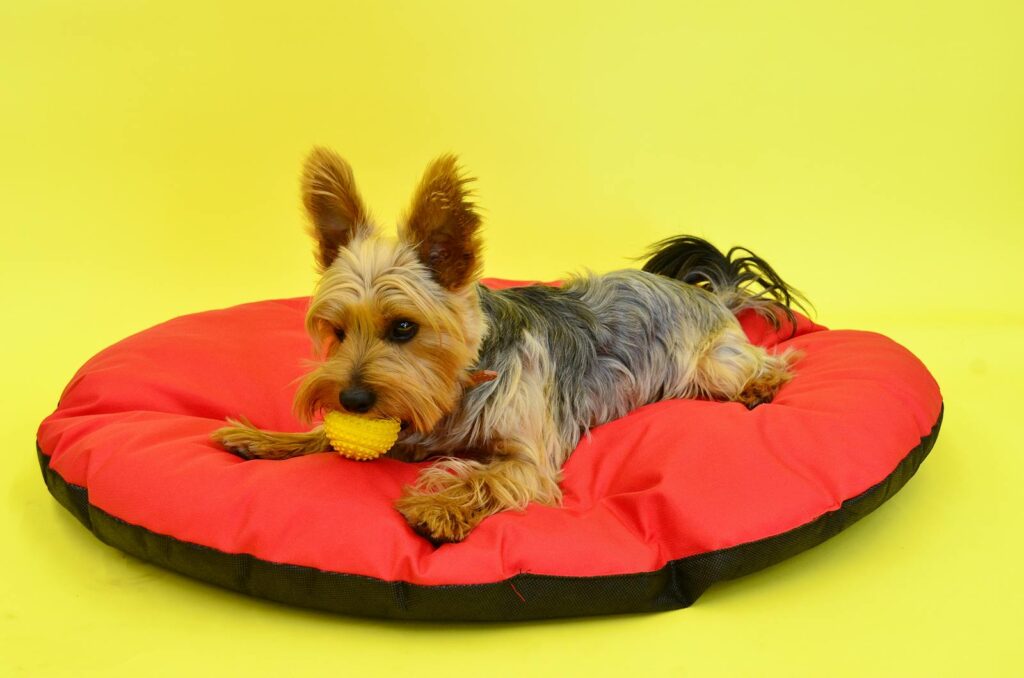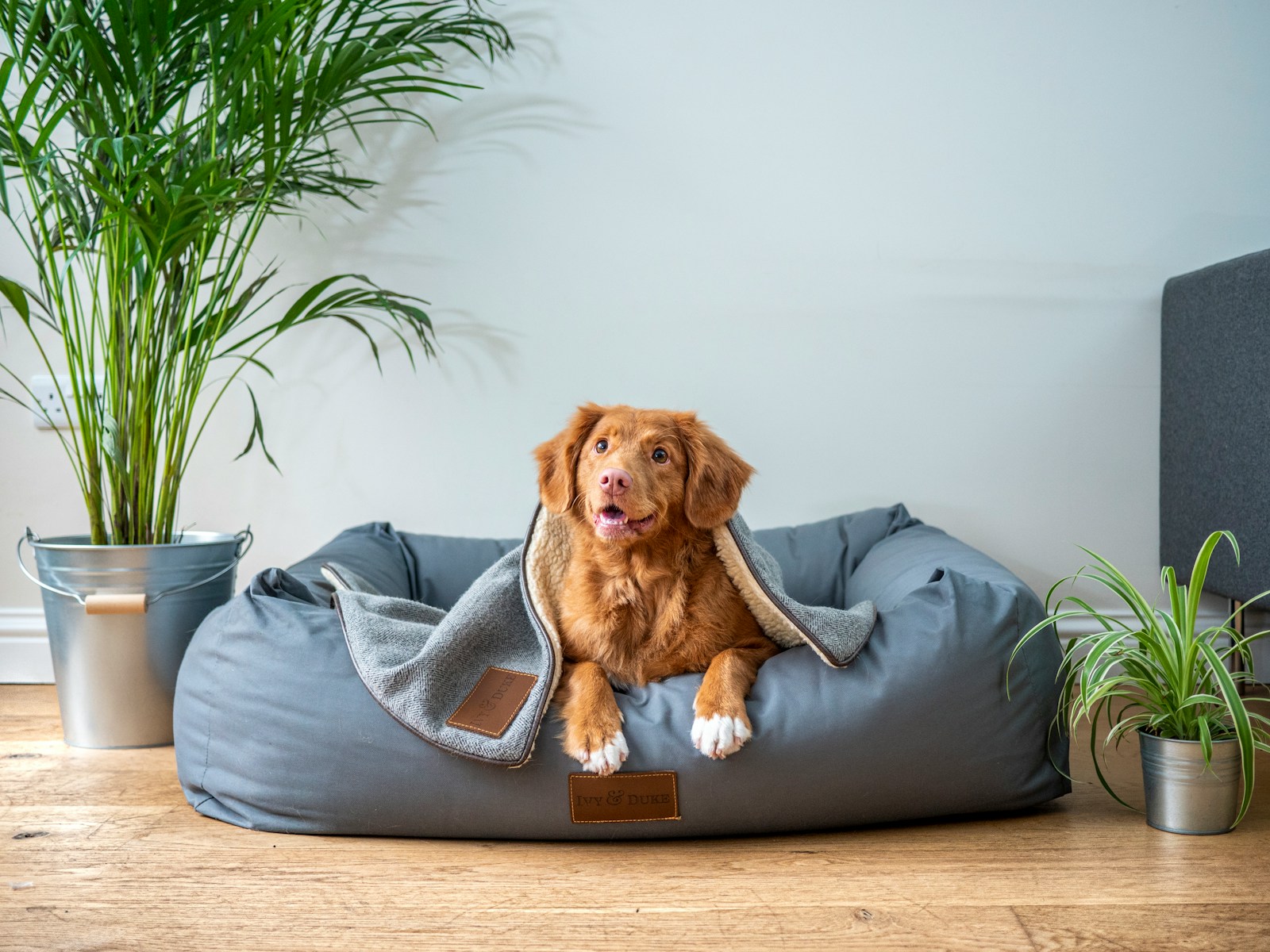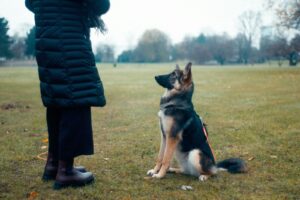Every dog deserves a sanctuary where they feel secure and relaxed. A thoughtfully designed space boosts your dog’s happiness and mitigates anxiety and behavioral issues.
Whether you’re a new pet parent or upgrading your current setup, this guide covers everything from selecting the perfect bed to dog-proofing your home. Let’s transform your space into a tail-wagging haven!
Table of Contents
1. Designating a Safe Zone
Your dog’s safe zone should be a quiet, low-traffic area where they can retreat. Consider these factors:
Location
- Corners: Choosing corners in living rooms, bedrooms, or under stairs creates a secluded, den-like environment that many dogs find comforting. It provides them with a sense of security and a retreat from the hustle and bustle of household activity.
- Avoid Noisy Appliances: Placing your dog’s space away from noisy appliances like washing machines, dishwashers, or dryers is important because loud noises can stress your dog. A calm and quiet area helps them feel more relaxed and safe.
Size
- Proper Fit: The space should be large enough for your dog to stretch out comfortably but not so large that it feels open and insecure. A cozy, enclosed area mimics a natural den, which is instinctively appealing to dogs. This helps them feel protected and at ease.
Accessibility
- Ease of Access: Easy access to their designated space is crucial for puppies and senior dogs. Puppies might struggle with steps or high entries, and senior dogs often have mobility issues. A spot that they can reach without having to climb stairs ensures that they can get to their resting place effortlessly, maintaining their comfort and safety.
By considering these factors, you create a perfect resting spot that meets your dog’s needs for comfort, security, and accessibility.
Pro Tip: Use baby gates to section off areas while allowing visibility.
2. Choosing the Right Bed
A quality bed supports joints and enhances sleep.

Materials
- Memory Foam for Seniors: Older dogs often suffer from joint pain or arthritis, making memory foam an ideal choice. Memory foam beds provide excellent support by conforming to the dog’s body shape, reducing pressure on their joints, and ensuring a comfortable rest. This can help alleviate discomfort and improve their overall quality of life.
- Waterproof Liners for Puppies: Puppies are prone to accidents, so having a waterproof liner is essential. A waterproof liner protects the bed from urine, drool, and other messes, making it easier to clean and maintain. It also helps extend the life of the bed, ensuring it remains hygienic and comfortable for your growing pup.
Size
- Proper Measurements: To find the right size bed for your dog, measure your dog from the tip of their nose to the base of their tail while they are stretched out. This ensures they have enough space to lie comfortably without being cramped. Add an additional 6–12 inches to this measurement to provide extra room for stretching and moving around. The added space ensures that your dog can lie in various positions comfortably.
Washability
- Removable, Machine-Washable Covers: Dogs can get dirty and bring that dirt into their beds. Therefore, it’s crucial to have a bed with a removable, machine-washable cover. This feature makes cleaning easy and convenient, ensuring that the bed remains fresh and odor-free. Regularly washing the cover helps maintain a hygienic sleeping environment, reducing the risk of skin irritations and infections for your dog.
By carefully considering the materials, size, and washability, you can select a dog bed that meets your pet’s specific needs, ensuring they have a comfortable and clean place to rest.
Did You Know? Elevated beds improve airflow, ideal for warmer climates.
3. Dog-Proofing Your Home
Creating a safe environment for your dog means eliminating potential hazards that could harm them. Dogs are naturally curious, and their exploration can sometimes lead to dangerous situations. Here’s how to dog-proof your home effectively:
1. Toxic Plants: Avoid Lilies, Aloe, and Philodendrons
Many common houseplants are toxic to dogs and can cause anything from mild stomach upset to severe poisoning. For example, lilies, aloe vera, and philodendrons can irritate your dog’s mouth, cause vomiting, or even lead to kidney failure. To keep your dog safe:
- Research pet-safe plants like spider plants or Boston ferns.
- Use the ASPCA’s list of toxic and non-toxic plants as a guide.
- Place plants out of reach or opt for artificial alternatives.
2. Secure Trash: Use Lidded Bins
Dogs are natural scavengers and may rummage through trash for food scraps or interesting smells. This can lead to ingestion of harmful items like bones, plastic, or toxic substances. To prevent this:
- Use trash cans with secure, dog-proof lids.
- Store trash bins in cabinets or behind closed doors.
- Train your dog to avoid the trash area using positive reinforcement.
3. Cords & Chemicals: Hide Wires and Store Cleaners Safely
Electrical cords and household chemicals pose serious risks. Chewing on cords can cause electric shocks or burns, while ingesting cleaning products can be toxic. To protect your dog:
- Use cord covers or hide wires behind furniture.
- Store chemicals in high cabinets or locked storage areas.
- Choose pet-safe cleaning products whenever possible.
By addressing these hazards, you’ll create a safer, stress-free environment for your dog to thrive in. 🐾
Checklist: Anchor heavy furniture, lock medications, and cover sharp edges.
4. Temperature Control
Dogs are highly sensitive to extreme temperatures, so keeping them comfortable in different seasons is essential for their well-being.
- Summer: Dogs can easily overheat, so it’s important to provide cooling mats, shaded areas, and access to plenty of fresh water. Avoid hot pavement, as it can burn their paws, and never leave them in a parked car.
- Winter: Cold temperatures can be just as dangerous. Heated beds or blankets can help, but avoid leaving electric blankets unattended. Short-haired or small dogs may benefit from sweaters or coats.
- Ventilation: Proper airflow is crucial in all seasons. Fans or cracked windows can help regulate temperature, but avoid direct drafts, as they can cause discomfort or illness.
Breed Note: Short-haired breeds (e.g., Greyhounds) need extra warmth.
5. Mental Stimulation & Enrichment

Boredom leads to destructive behavior.
Keeping your dog mentally stimulated is just as crucial as physical exercise. By incorporating various activities and strategies, you can ensure your furry friend stays engaged and happy. Here are some effective ways to enrich your dog’s life:
Puzzle Feeders
Puzzle feeders like KONGs or Outward Hound games provide a fun and challenging way for your dog to eat their meals or treats. These toys require your dog to solve puzzles to access the food inside, stimulating their problem-solving skills and keeping them occupied.
- Encourage your dog to use their nose and paws.
- Slow down their eating, aiding digestion.
- Provide a rewarding mental workout.
Toy Rotation
To maintain your dog’s interest and prevent boredom, try rotating their toys on a weekly basis. This strategy keeps their environment exciting and stimulating, as they encounter different textures, shapes, and sounds.
- Swap out toys every week.
- Keep a few favorites in regular rotation.
- Introduce new toys occasionally to add variety.
Training Sessions
Short, 10-minute training sessions are a great way to keep your dog’s mind active while building their skills. These sessions can focus on reinforcing basic commands or teaching new tricks, providing both mental stimulation and strengthening the bond between you and your dog.
- Incorporate daily drills for commands or tricks.
- Use positive reinforcement with treats and praise.
- Keep sessions short to maintain focus and prevent frustration.
By integrating puzzle feeders, toy rotation, and regular training sessions into your dog’s routine, you can ensure they remain mentally stimulated and enriched. These activities not only enhance their cognitive abilities but also improve their overall well-being and happiness.
Pro Tip: Hide treats around the space for a scavenger hunt!
6. Setting Up a Feeding Station

A calm and comfortable eating environment can significantly impact your dog’s health and behavior. Here’s how to optimize their dining space:
1. Choose the Right Location
- Place food and water bowls in a quiet, low-traffic area to reduce stress and distractions.
- Avoid feeding near doorways, noisy appliances, or high-activity zones where people or other pets frequently pass by.
- If you have multiple dogs, consider separate feeding stations to prevent competition or food aggression.
2. Select the Best Bowls
- Stainless Steel Bowls: These are durable, rust-resistant, and easy to clean, reducing bacteria buildup compared to plastic bowls.
- Ceramic Bowls: Heavy and sturdy, these prevent tipping but must be checked for cracks that can harbor bacteria.
- Elevated Bowls: Helpful for large or senior dogs, raised bowls promote better digestion and reduce strain on the neck and joints.
3. Prioritize Hydration
- Spill-Proof Water Bowls: Great for messy drinkers or active dogs that tend to knock over bowls.
- Water Fountains: Keep water fresh, filtered, and oxygenated, encouraging dogs to drink more and stay hydrated.
- Multiple Water Stations: If you have a large home, placing additional water bowls in different areas ensures easy access.
By setting up a stress-free dining area, you create a safe and enjoyable space for your dog, promoting better digestion, hydration, and overall well-being.
Note: Wash bowls daily to prevent bacteria buildup.
7. Safety When Home Alone
Dogs can experience separation anxiety when left alone, but with the right approach, you can help them feel more secure and comfortable.
1. Crate Training for a Safe Space
- A crate can serve as a safe and comforting retreat for your dog when you’re not home.
- Introduce the crate gradually using positive reinforcement, like treats and praise, to create a positive association.
- Ensure the crate is the right size—big enough for your dog to stand, turn around, and lie down comfortably but not too spacious.
- Never use the crate as punishment; instead, make it a cozy, inviting space with a soft bed, toys, and a chew treat.
2. Monitor with Pet Cameras
- Interactive pet cameras, such as Furbo or Petcube, let you check in on your dog via a smartphone app.
- Some cameras dispense treats remotely, allowing you to reinforce good behavior even when you’re not home.
- Two-way audio features let you talk to your dog, which can be reassuring for dogs prone to anxiety.
3. Calming Aids for Anxious Dogs
- Adaptil Diffusers: These release synthetic pheromones that mimic a mother dog’s natural calming scent, helping dogs feel more at ease.
- ThunderShirts: These snug-fitting wraps provide gentle, constant pressure, similar to a swaddle, which can reduce anxiety during your absence.
- Calming Treats & Supplements: Natural ingredients like L-theanine, chamomile, and CBD can help some dogs relax.
By implementing these strategies, you can reduce anxiety, promote safety, and ensure your dog remains comfortable while you’re away.
Caution: Avoid leaving collars on to prevent choking hazards.
8. Regular Maintenance & Upkeep
Maintaining a clean and well-organized environment for your dog is essential for their physical health and emotional well-being. A tidy space reduces the risk of infections, allergies, and accidents, while also creating a more pleasant living area for both you and your pet. Here’s a detailed breakdown of how to keep your dog’s space clean and safe:
1. Weekly Cleaning Routine
Consistency is key when it comes to maintaining a healthy space for your dog. A weekly cleaning routine ensures that dirt, bacteria, and allergens don’t build up.
- Wash Bedding:
Your dog’s bed can harbor dirt, hair, and bacteria. Wash their bedding weekly using a pet-safe detergent to prevent skin irritations or allergies. Opt for machine-washable beds for convenience.- Tip: Use hot water to kill bacteria and dust mites.
- Sanitize Toys:
Chew toys and plush toys can collect saliva, dirt, and germs. Clean hard toys with warm, soapy water, and toss plush toys in the washing machine.- Tip: Inspect toys for damage (e.g., loose parts) and replace them if necessary.
- Vacuum Hair:
Dog hair can accumulate quickly, especially during shedding seasons. Vacuum floors, furniture, and corners weekly to reduce allergens and keep your home tidy.- Tip: Use a vacuum with a pet hair attachment for better results.
2. Monthly Inspections
A monthly deep dive into your dog’s space helps identify potential hazards and ensures everything is in good condition.
- Inspect for Wear and Tear:
Check your dog’s belongings for signs of damage, such as:- Chewed wires or cords (replace or secure them).
- Loose bolts or screws on furniture or crates (tighten or repair).
- Torn bedding or toys (replace to prevent choking hazards).
- Deep Clean Floors and Surfaces:
Use pet-safe cleaners to mop floors and wipe down surfaces. Pay special attention to areas where your dog spends the most time.- Tip: Avoid harsh chemicals like bleach, which can harm your dog.
- Check for Pests:
Regularly inspect your dog’s space for fleas, ticks, or other pests. Wash bedding and vacuum thoroughly to prevent infestations.
3. Regular Vet Visits

A clean space is only one part of keeping your dog healthy. Regular vet visits are crucial for addressing health-related behavior changes and ensuring your dog’s overall well-being.
- Schedule Check-Ups:
Annual or bi-annual vet visits help catch potential health issues early. Discuss any changes in your dog’s behavior, such as excessive scratching, lethargy, or changes in appetite.- Tip: Keep a journal of your dog’s habits to share with your vet.
- Address Health-Related Behavior Changes:
If your dog starts chewing furniture, scratching excessively, or avoiding their bed, it could indicate an underlying health issue. Your vet can help diagnose and treat problems like allergies, joint pain, or anxiety. - Stay Up-to-Date on Vaccinations and Preventatives:
Regular vet visits ensure your dog is protected against diseases, parasites, and other health risks.
Reminder: Replace worn-out toys and beds every 1–2 years.
Conclusion
Crafting a safe, comfortable space for your dog fosters their physical and emotional health. By prioritizing their needs—from a supportive bed to mental enrichment—you’ll strengthen your bond and ensure they thrive. Start small, observe their preferences, and adapt as needed.
Are these tips helpful? Share this guide with fellow dog lovers or tag us in photos of your pup’s new space! Subscribe for more pet care insights, and drop a comment below with your top dog-proofing hack. 🐾






Pingback: Copaiba, Krill Oil & DHA: 3 Powerful Supplements for a Dog